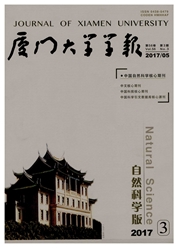

 中文摘要:
中文摘要:
以海藻酸钠(sodium alginate,SA)和壳聚糖(chitosan,CS)为纳米粒包被材料,构建胰岛素(insulin,INS)多糖纳米粒.采用基质辅助激光解吸电离飞行时间(Matrix-assisted laser desorption ionization/time of flight,MALDI-TOF)质谱技术研究若干化学因素影响INS-多糖纳米粒的稳定性.选用电子光谱技术研究INS-多糖纳米粒控释INS速率及动力学特性.实验结果表明,INS-SA纳米粒在Tris-HCl缓冲液(pH7.2)和醋酸介质中均呈不稳定状态,易释放INS;而INS-CS纳米粒在Tris-HCl缓冲液中呈较为稳定状态,其释放INS速率明显慢于INS-SA纳米粒,并遵循一级反应动力学过程.INS-SA和INS-CS纳米粒均能有控制INS释放速率能力,但两者释放速率明显不同,其速率可分为快速与慢速释放方式.CS比SA更适合于作为包被材料研制INS-多糖纳米粒口服制剂.
 英文摘要:
英文摘要:
Sodium alginate(SA) and chitosan(CS) as encapsulated materials were used to encapsulate into the polysaccharide nanoparticle of insulin. The stability of these nanoparticles effected with several chemical factors was further studied by matrix-assisted laser desorption ionization/time of flight mass spectrometry(MALDl-TOF MS). Moreover, the rate of controlled release insulin(ISN) and its kinetic characteristics from the SA-nanoparticles of INS were measured with electronic spectral technology. The experimental results indicated that SA-nanoparticles of INS showed unstable characteristics under the condition of both Tris-HCl buffer(pHT. 2) and acetic acids,respectively, because of insulin release easily. Contrarily, INS within the polysaccharide nanoparticle of CS was suggested to be stability due to rate of insulin release in later was much lower than that in front. It is indicated that this kinetic pathway followed first-order reaction. Even so, both INS-SA and INS-CS nanoparticles had still capacities for controlling the rate, but both rates went along different evidently,which can be divided into quick and slow approaches. Here,we indicated that CS rather than SA as encapsulated materials is suit for preparing oral drug of INS encapsulated with polysaccharide nanoparticle.
 同期刊论文项目
同期刊论文项目
 同项目期刊论文
同项目期刊论文
 期刊信息
期刊信息
